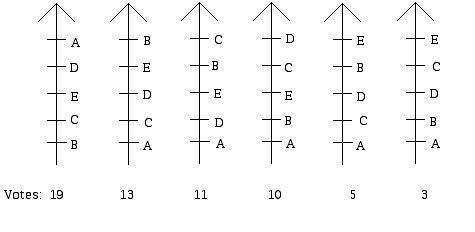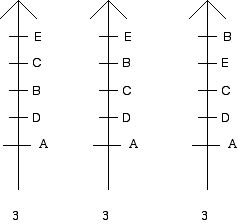
Practice 1: Elections
Prepared by:
Joseph Malkevitch
Mathematics Department
York College (CUNY)
Jamaica, NY 11451
email:
malkevitch@york.cuny.edu
web page:
http://york.cuny.edu/~malk/
Given the election below:

Note: In solving the problems below there may be ties and/or the method may not be decisive, that is, it may not yield a winner.
1. Decide the winner using plurality.
2. Decide the winner using run-off
3. Decide the winner using sequential run-off
4. Decide the winner using the Borda Count
5. Decide the winner using Condorcet
6. Decide the winner using Coombs
7. Decide the winner using a Borda Count sequential run -off (Baldwin's method)
8. How might you modify the 7 decision procedures above so that instead of producing a single winner a ranking is produced? Using your proposed scheme, what rankings result from the 7 methods above?
9. Recompute the winner of the election above using sequential run off where the last column of 3 ballots is replaced by the 3 votes in the diagram below reading from left to right. (Three new elections are involved; first using the leftmost schedule; another using the middle schedule, and finally, the rightmost schedule.) (Note: what is happening here is that position of B on the original set of ballots is being changed so that B is ranked higher, without changing the position of the other candidates.) How, if at all, does the winner of the election change when the substitution of ballots is made? Do the results accord with your intuition about what "should" happen?
